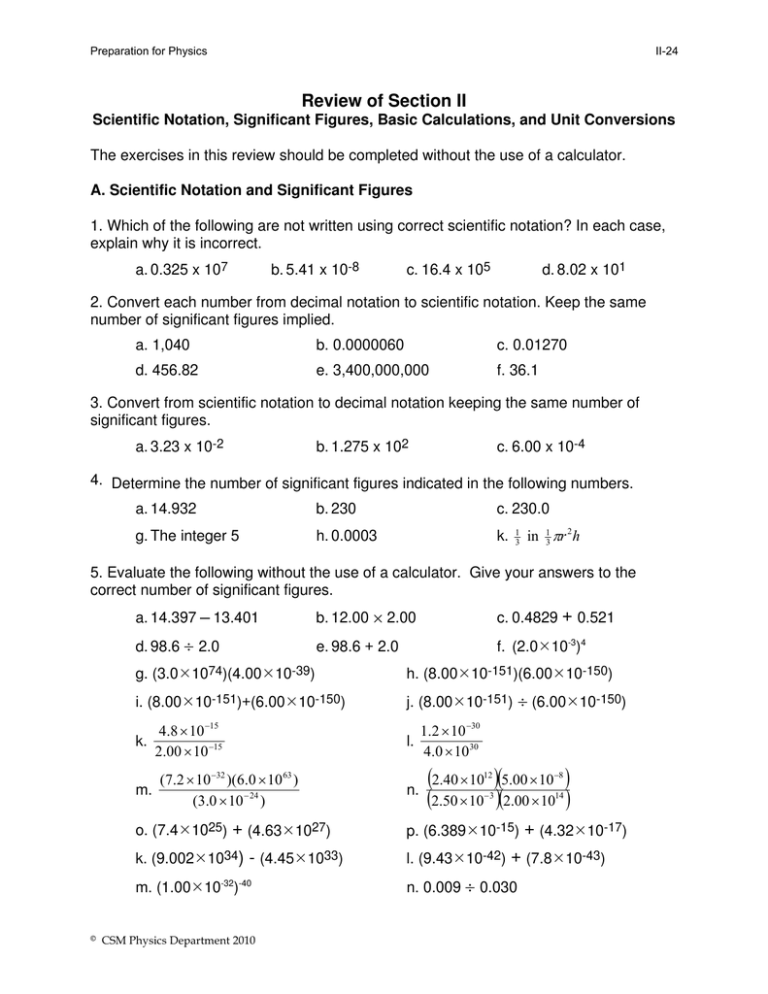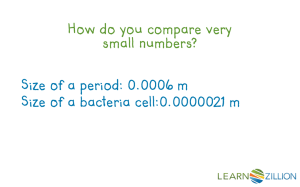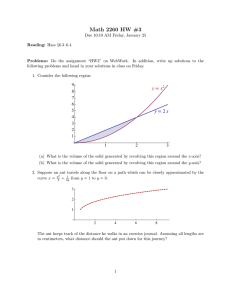Review of Section II
advertisement

Preparation for Physics II-24 Review of Section II Scientific Notation, Significant Figures, Basic Calculations, and Unit Conversions The exercises in this review should be completed without the use of a calculator. A. Scientific Notation and Significant Figures 1. Which of the following are not written using correct scientific notation? In each case, explain why it is incorrect. a. 0.325 x 107 b. 5.41 x 10-8 c. 16.4 x 105 d. 8.02 x 101 2. Convert each number from decimal notation to scientific notation. Keep the same number of significant figures implied. a. 1,040 b. 0.0000060 c. 0.01270 d. 456.82 e. 3,400,000,000 f. 36.1 3. Convert from scientific notation to decimal notation keeping the same number of significant figures. a. 3.23 x 10-2 b. 1.275 x 102 c. 6.00 x 10-4 4. Determine the number of significant figures indicated in the following numbers. a. 14.932 b. 230 c. 230.0 g. The integer 5 h. 0.0003 k. 1 3 in 13 πr 2 h 5. Evaluate the following without the use of a calculator. Give your answers to the correct number of significant figures. a. 14.397 — 13.401 b. 12.00 μ 2.00 c. 0.4829 + 0.521 d. 98.6 ÷ 2.0 e. 98.6 + 2.0 f. (2.0¯10-3)4 g. (3.0¯1074)(4.00¯10-39) h. (8.00¯10-151)(6.00¯10-150) i. (8.00¯10-151)+(6.00¯10-150) j. (8.00¯10-151) ÷ (6.00¯10-150) k. m. 4.8 × 10 −15 2.00 × 10 −15 (7.2 × 10 −32 )(6.0 × 10 63 ) (3.0 × 10 − 24 ) l. n. 1.2 × 10 −30 4.0 × 1030 (2.40 × 10 )(5.00 × 10 ) (2.50 × 10 )(2.00 × 10 ) 12 −8 −3 14 o. (7.4¯1025) + (4.63¯1027) p. (6.389¯10-15) + (4.32¯10-17) k. (9.002¯1034) - (4.45¯1033) l. (9.43¯10-42) + (7.8¯10-43) m. (1.00¯10-32)-40 n. 0.009 ÷ 0.030 © CSM Physics Department 2010 Preparation for Physics II-25 B. Basic Calculations and Unit Conversions All calculations below should be done to the correct number of significant figures. 1. You measure the length, width, and height of a wooden block to be 12.0 cm, 5.0 cm and 4.0 cm respectively. You also measure the mass of the block to be 120.0 g. (a) Compute the volume of the block. (b) Convert the volume found in (a) to m3. (c) Compute the density of the block in g/cm3. Recall that density is mass divided by volume. (d) Convert the density calculated in part (c) to kg/m3. 2. You count out 12 pennies and measure their total mass to be 24.6 g. Assuming all pennies have the same mass, calculate the mass of one penny. 3. You repeat your experiment this time counting out exactly 100 pennies and measuring their total mass to be 253.8 g. (a) Again assuming all pennies to have the same mass, calculate the mass of one penny. (b) Convert the mass you found in part (a) to kg. Report your answer using proper scientific notation. (c) Convert the mass you found in part (a) to mg. Report your answer using proper scientific notation. 4. Let north be the positive direction. You walk 9.00 m north, then 7.00 m south. It takes you a total of 20.0 s. (a) What was your total displacement? (b) What was your average velocity? (c) What was your average speed? (d) Convert your average speed to km/min. 5. Bored during a long weekend with no physics class, you watch an ant and record its motion. The ant walks 40.0 cm west, turns around, walks 20.0 cm east, turns again, and walks 30.0 cm west. All of this in a period of 20.0 min. (a) Sketch the ant’s walk. Select a positive direction and label it in your sketch. (b) What was the ant’s total displacement? (c) What was the ant’s average velocity? (d) What was the ant’s average speed? (e) Was the ant’s average speed less than, equal to, or greater than the magnitude of the ant’s average velocity? (f) Convert the ant’s average speed to m/s and to km/h. © CSM Physics Department 2010




